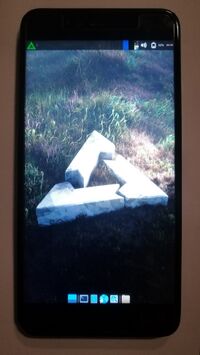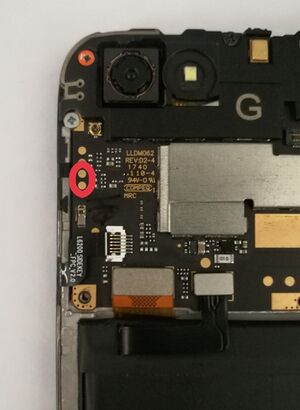Xiaomi Redmi Note 5A: Difference between revisions
No edit summary |
|||
| Line 16: | Line 16: | ||
| architecture = aarch64 | | architecture = aarch64 | ||
| type = handset | | type = handset | ||
| status_usbnet = Y | | status_usbnet = Y | ||
| status_flashing = Y | | status_flashing = Y | ||
| status_touch = Y | | status_touch = Y | ||
| status_screen = | | status_screen = Y | ||
| status_wifi = Y | | status_wifi = Y | ||
| status_xwayland = | | status_xwayland = Y | ||
| status_fde = | | status_fde = Y | ||
| status_mainline = | | status_mainline = Y | ||
| status_battery = Y | | status_battery = Y | ||
| status_3d = | | status_3d = Y | ||
| status_audio = N | | status_audio = N | ||
| status_bluetooth = | | status_bluetooth = Y | ||
| status_camera = | | status_camera = N | ||
| status_gps = | | status_gps = N | ||
| status_mobiledata = | | status_mobiledata = N | ||
| status_sms = | | status_sms = N | ||
| status_calls = | | status_calls = N | ||
| status = | | status = | ||
| status_otg = | | status_otg = N | ||
| status_nfc = - | | status_nfc = - | ||
| status_usba = - | | status_usba = - | ||
| Line 43: | Line 42: | ||
| status_irtx = <!-- Infrared (IR) port works --> | | status_irtx = <!-- Infrared (IR) port works --> | ||
| status_trustzone = <!-- TrustZone works --> | | status_trustzone = <!-- TrustZone works --> | ||
| status_accel = | | status_accel = N | ||
| status_magnet = | | status_magnet = N | ||
| status_light = | | status_light = N | ||
| status_proximity = | | status_proximity = N | ||
| status_hall = | | status_hall = N | ||
| status_barometer = | | status_barometer = - | ||
| status_powersensor = | | status_powersensor = - | ||
| booting = yes | | booting = yes | ||
| n-android = ✔ | | n-android = ✔ | ||
| pmoskernel = 6.12.5 | |||
| pmoskernel = | |||
}} | }} | ||
Revision as of 15:08, 1 January 2025
 Xiaomi Redmi Note 5A running XFCE4 | |
| Manufacturer | Xiaomi |
|---|---|
| Name | Redmi Note 5A Prime |
| Codename | xiaomi-ugg |
| Released | 2017 |
| Type | handset |
| Hardware | |
| Chipset | Qualcomm Snapdragon 435 (MSM8940) |
| CPU | 1.4 GHz Cortex-A53 |
| GPU | Adreno 505 |
| Display | 720x1280 IPS LCD |
| Storage | 32G |
| Memory | 3GB |
| Architecture | aarch64 |
| Software | |
| Original software | Android (MIUI) |
| Original version | 7.1.2 (MIUI 11) |
| postmarketOS | |
| Category | testing |
| Pre-built images | no |
| Mainline | yes |
| postmarketOS kernel | 6.12.5 |
| Flashing |
Works |
|---|---|
| USB Networking |
Works |
| Internal storage |
No data |
| SD card |
No data |
| Battery |
Works |
| Screen |
Works |
| Touchscreen |
Works |
| Multimedia | |
| 3D Acceleration |
Works |
| Audio |
Broken |
| Camera |
Broken |
| Camera Flash |
No data |
| IR TX |
No data |
| Connectivity | |
| WiFi |
Works |
| Bluetooth |
Works |
| GPS |
Broken |
| Modem | |
| Calls |
Broken |
| SMS |
Broken |
| Mobile data |
Broken |
| Miscellaneous | |
| FDE |
Works |
| USB OTG |
Broken |
| Sensors | |
| Accelerometer |
Broken |
| Magnetometer |
Broken |
| Ambient Light |
Broken |
| Proximity |
Broken |
| Hall Effect |
Broken |
| Haptics |
No data |
Contributors
- Flafflar
Users owning this device
- Bczeman
- Filip2cz (Notes: Prime version - this just added fingerprint reader, better camera and littlebit better cpu)
- Flafflar (Notes: Broken camera)
- Xiaoyu2006 (Notes: Broken display)
How to enter flash mode
While the phone is off, hold the + buttons together for a few seconds.
How to enter EDL mode
EDL mode (Emergency Download Mode) is a special mode in Qualcomm devices that allows, among other things, flashing firmware even when the phone is completely bricked. This might come useful in case something goes extremely wrong and the device won't even boot to fastboot.
To boot into EDL, you must first disassemble the device in order to expose the motherboard points required. This phone is very easy to disassemble, you can search for videos on YouTube if necessary. Once you have removed the back case and disconnected the battery, find the points shown below on the motherboard:
These are the test points that enable EDL mode. With the battery disconnected, use a metal tweezer or a small wire to short these two points. While keeping them sorted, plug the phone to a computer. The device should show up as "Qualcomm HS-USB QDLoader 9008". You can now use this tool to download firmware to your device.
Installation
- Follow the Installation guide
| Warning: Flashing lk2nd is required, as it is a hard dependency. Without it the mainline kernel will not select the display panel (resulting in black screen on boot). |
$ pmbootstrap init # choose Vendor: qcom Device codename: msm89x7
$ pmbootstrap install
$ pmbootstrap flasher flash_lk2nd
$ pmbootstrap flasher flash_rootfs
Display
Both the display and the touchscreen work normally, although the interface won't show up if you are using LightDM. This happens because for whatever reason logind does not recognize the user's session as graphical. To fix this, edit /etc/lightdm/lightdm.conf and add the line logind-check-graphical=false to force LightDM to start the graphical session. See this article for more info: Display_manager#CanGraphical_issue.
The display also has trouble waking up after being put to sleep. The backlight is enabled as expected, but the screen stays blank.
WiFi
The WiFi works, but only with the proprietary firmware distributed with the phone. Make sure to enable nonfree firmware if you need to use WiFi.
When the WCNSS driver gets enabled, it might complain with the following error:
[ 140.798259] wcnss: no space available for smd frame
This is probably a false error. After the firmware is loaded, the interface appears and works correctly, so you can ignore it.
